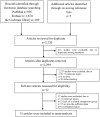Association among obesity, overweight and autism spectrum disorder: a systematic review and meta-analysis
- PMID: 28916794
- PMCID: PMC5601947
- DOI: 10.1038/s41598-017-12003-4
Association among obesity, overweight and autism spectrum disorder: a systematic review and meta-analysis
Abstract
Obesity, overweight and autism spectrum disorder (ASD) remain serious public health problems. Although lots of studies have recently explored the association among obesity, overweight and ASD, the findings are inconsistent. Thus, we conducted a meta-analysis of epidemiological studies to examine the association among obesity, overweight and ASD. PubMed, Embase, and the Cochrane Library were used for literature searches to identify eligible studies published in English before November 15, 2016. Relevant studies estimating the association among obesity, overweight and ASD were included. Fifteen studies encompassing 49,937,078 participants and 1,045,538 individuals with ASD were included in this study. A random effects model was chosen to synthesize the effect sizes of individual studies. The prevalence of obesity was significantly higher in individuals with ASD than in controls (OR = 1.84, 95% confidence interval [CI]: 1.37-2.48, P < 0.001). However, the prevalence of overweight in individuals with ASD was not significantly different from that in controls (OR = 1.07, 95% CI: 0.83-1.38, P = 0.62). Both sensitivity analysis and publication bias testing revealed that the findings were robust. The meta-analysis showed a significant association between obesity and ASD. However, no significant association was identified between overweight and ASD.
Conflict of interest statement
The authors declare that they have no competing interests.
Figures





Similar articles
-
Autism Spectrum Disorder and Obesity in Children: A Systematic Review and Meta-Analysis.Obes Facts. 2022;15(3):305-320. doi: 10.1159/000523943. Epub 2022 Mar 9. Obes Facts. 2022. PMID: 35263756 Free PMC article.
-
Association between schizophrenia and autism spectrum disorder: A systematic review and meta-analysis.Autism Res. 2018 Aug;11(8):1110-1119. doi: 10.1002/aur.1977. Epub 2018 Oct 3. Autism Res. 2018. PMID: 30284394
-
Association between Asthma and Autism Spectrum Disorder: A Meta-Analysis.PLoS One. 2016 Jun 3;11(6):e0156662. doi: 10.1371/journal.pone.0156662. eCollection 2016. PLoS One. 2016. PMID: 27257919 Free PMC article.
-
Association between parental body mass index and autism spectrum disorder: a systematic review and meta-analysis.Eur Child Adolesc Psychiatry. 2019 Jul;28(7):933-947. doi: 10.1007/s00787-018-1259-0. Epub 2018 Nov 23. Eur Child Adolesc Psychiatry. 2019. PMID: 30470952
-
Global prevalence of obesity, overweight and underweight in children, adolescents and adults with autism spectrum disorder, attention-deficit hyperactivity disorder: A systematic review and meta-analysis.Obes Rev. 2020 Dec;21(12):e13123. doi: 10.1111/obr.13123. Epub 2020 Aug 11. Obes Rev. 2020. PMID: 32783349
Cited by
-
Evaluation of Appetite-Regulating Hormones ın Young Children with Autism Spectrum Disorder.J Autism Dev Disord. 2021 Feb;51(2):632-643. doi: 10.1007/s10803-020-04579-0. J Autism Dev Disord. 2021. PMID: 32583136
-
Neophobia, sensory experience and child's schemata contribute to food choices.Eat Weight Disord. 2024 Apr 8;29(1):25. doi: 10.1007/s40519-024-01657-5. Eat Weight Disord. 2024. PMID: 38587606 Free PMC article. Review.
-
Association between dyslexia and overweight/obesity among Chinese children: findings from a cross-sectional study.Front Pediatr. 2025 Jul 16;13:1600848. doi: 10.3389/fped.2025.1600848. eCollection 2025. Front Pediatr. 2025. PMID: 40740817 Free PMC article.
-
Problematic behaviors at mealtimes and the nutritional status of Brazilian children with Autism Spectrum Disorder.Front Public Health. 2024 Oct 14;12:1392478. doi: 10.3389/fpubh.2024.1392478. eCollection 2024. Front Public Health. 2024. PMID: 39469204 Free PMC article.
-
Autism Spectrum Disorder and Obesity in Children: A Systematic Review and Meta-Analysis.Obes Facts. 2022;15(3):305-320. doi: 10.1159/000523943. Epub 2022 Mar 9. Obes Facts. 2022. PMID: 35263756 Free PMC article.
References
Publication types
MeSH terms
LinkOut - more resources
Full Text Sources
Other Literature Sources
Medical

